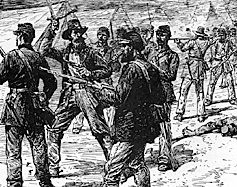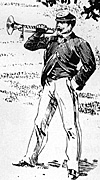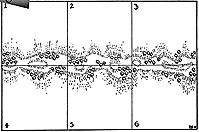
A Solo or multi- player game using Fire & Fury
rules, but could be used for any period with a sensible set of rules for fun and individual flair. If you decide on the multi player version this scenario can accommodate around 2 - 5
players with no umpire required (more if you expand the scenario size) and is easily playable
in an evening.
EDITOR
I hope Kenn doesn't mind me butting in here but I'd just like to emphasise his point that this scenario can be used for any period. I plan to put it on for my club (any Exiles
reading this - stop now!) and am torn between setting it in the ACW, ECW (1643 in the west), any
of the various Roman Civil Wars or a modern South American skirmish type game. I'd also like
to urge all of you to look at the extremely elegant setting up a camp rules.
THE GROUND
The suggested table size is 6' x 4'. There is a lightly wooded ridge running down the
centre of this. Part of the ridge can be made steep and/or heavily wooded to add variety
to the game. The table is divided into 6 squares, 3 on either side of the ridge. The
squares are numbered 1-6 and a D6 thrown to see the divisional bivouac (bivvy) location.
A bivvy area for a division is a 2' square.
SITUATION
Your division has moved into a temporary bivvy area during the night. You have been
delayed throughout the day and have failed to reach the one you had planned to stay
at. There are no reports of the enemy in the area.
MISSION
Rest your troops for the night and resume your march in the morning towards your RV.
EXECUTION
Each brigade must be allocated a campsite (in the divisional bivvy area), the cavalry
must be allocated horse lines, the artillery formed into a park and the HQs sited. The
player(s) should draw a map of their bivvy area clearly marking all the camp positions.
One brigade, infantry or horse, must be allocated sentry duty and its position and
formation marked on the map (the duty brigade). It may be given instructions on
what to do at reveille the next morning if you wish.
ADMINISTRATION and LOGISTICS
There are no problems. The troops have food and fodder for 3 days and are well
supplied with ammunition.
HOW IT WORKS
Both commanders have decided on reveille at 5.00 am, just before dawn and their buglers act
accordingly. A D6 is then thrown for each unit in the division to see how long it takes them to
respond to this wake up call. At present there is no sense of urgency or danger. Place duty brigade.
DUTY BRIGADE
Unless they can actually see an enemy unit they will hold their position. If they can see the enemy they will act in accordance with the orders given the night before!
Game Move Two
Throw a D6 for the sluggards who would not get out of bed and consult Table 1 again. All units parading continue to do so (units which on turn 1 got a 'parade in 1 move' result are now placed on the table, those which got a 'parade in 2 moves' result are represented by 1 stand).
Game Move Three
Throw a D6 for any remaining sluggards (as above). Any units which paraded last move are now ready to move off to combat if required whilst those who started with a 'parade in 2 moves' result are now formed up and are ready for action from the start of next turn.
THEREAFTER
Continue the above until every unit is on parade or a war has started! Then play by
normal rules. once the first shot has been fired ignore a die roll of 1 on table 1. A bugle might not get your troops out of bed but a bullet passing close by does!
LARGER MULTI PLAYER GAME
Give each player a division to command (2 Rebs, 2 Yanks) and each individually rolls
for his bivvy area. (In this case friendly forces can bivvy in adjacent areas?). Maximum numbers should be 2 divisions a side which gives 2 free squares at the start of the game. There is no real requirement for an umpire.
PLAYING THE GAME
I have played this both solo and multi player with mixed success but always enjoyed it. Against an opponent I have set up in Area 6 with my duty brigade facing 3 (luck) and he was in 2 with his sentries facing 5. My duty brigade dashed out of the trees, overran his artillery park and routed a sluggish infantry brigade whilst he made mincemeat out of my sleeping cavalry. We both suffered from a unit that would not get out of bed. When it finally did it never moved above 1/2 speed due to the movement die (used in Fire & Fury).
In my solo game the fortunate positioning of the Confederate artillery on the 4/5 line in Area 4 made the piecemeal advance by the Yanks from Area 6 easy to contain. It was a close run thing, says he taking off his grey kepi.
Hope you have fun with this!
EDITOR'S COMMENTS
I'm sure Kenn would agree that those of you without tents could easily use markers etc. Also there is no real requirement to make the opposing forces exactly symmetrical or equal (in
composition, size or quality). Divisions could also be increased in size with players splitting the units between them.
Having tested for each unit, your division will be in some turmoil. To indicate this on the
tabletop:
 Game Move One
Game Move One
Table 1 Die Score Action 1 No movement yet, a bit sluggish, the officers are having difficulties prying the men away from their beds. 2 - 4 Parades in 2 games moves. Reluctant but will get up. 5 - 6 Parades in 1 games move. A Sgt. major's dream.
No Movement Tent Left in Place Parade in 2 Moves Remove tent and place 2 stands in that location. Parade in 1 Move Remove tent and place one stand in that location.

Back to Battlefields Vol. 1 Issue 5 Table of Contents
© Copyright 1996 by Partizan Press.
This article appears in MagWeb (Magazine Web) on the Internet World Wide Web.
Other military history articles and gaming articles are available at http://www.magweb.com